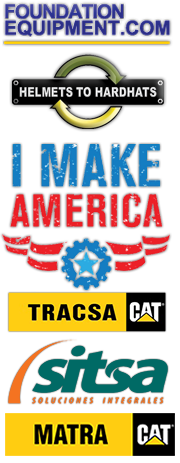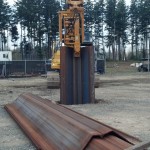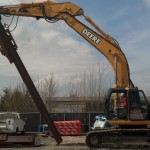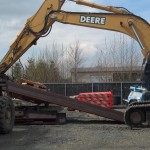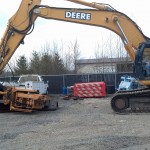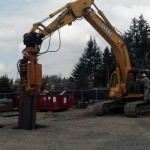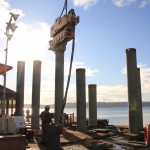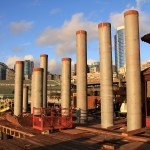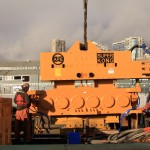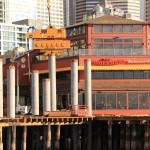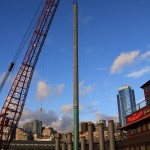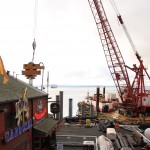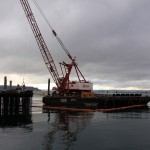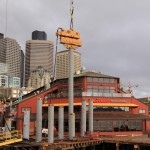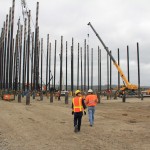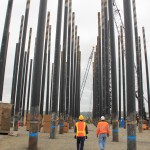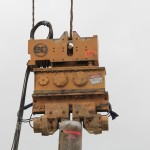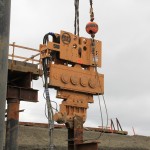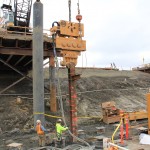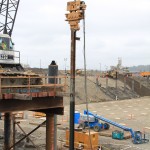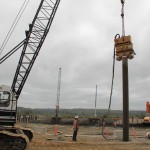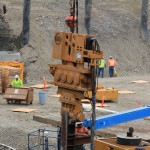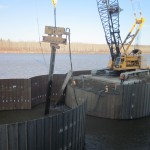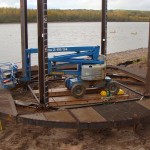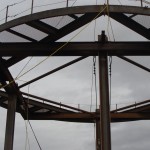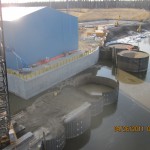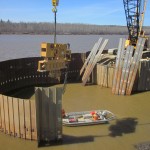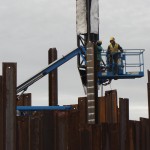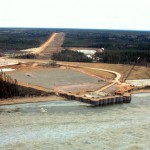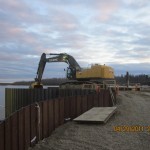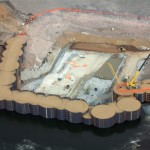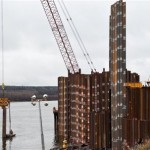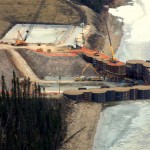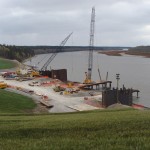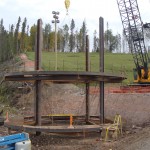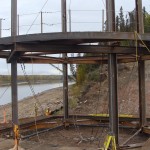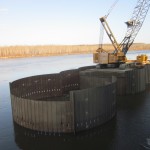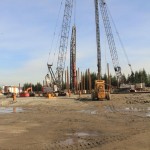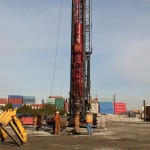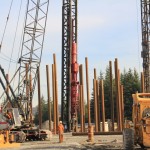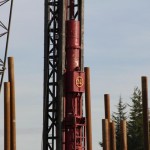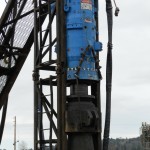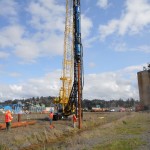Imco General Purchases the First RoboVibe in the PNW!
In January 2013, Imco General approached me with their dilemma- On this Everett, WA Highway job, they have limited space to properly sling up and drive their PZ sheet piles. So they need to be able to pick, load, and drive the sheets in one fell swoop with one piece of equipment, an operator, and a couple of ground guys. The obvious choice? The APE RoboVibe vibratory driver and extractor. With this unique excavator-mounted vibro, they would be able to pick up the sheets from the ground with the patented side-grip clamps and drive them from either the side or the top of their sheets. After some short talk of the advantages of the RoboVibe over the HMC SP-60 Sonic SideGrip Hammer, Imco General Construction finalized the purchase and received their brand new APE RoboVibe in early April. This is the first and only RoboVibe purchased in the Pacific Northwest. I had the personal pleasure of visiting Imco General at their Ferndale, WA office/yard and had the opportunity to observe the RoboVibe in action as they drove some PZC-26 sheet piles in their yard with their John Deere 330 excavator. This was an interesting as well as a very educational experience as I have never had the opportunity to see a RoboVibe in action before.
Imco General was satisfied as well as impressed with the final product; and they will be utilizing it on the Everett Highway job this upcoming May. They will also be renting an APE Model 50 Vibro Hammer to remove the sheets. Imco will be hanging the 50 vibro from an excavator and follow behind the RoboVibe for extraction. I hope to make it out to the jobsite in the upcoming month and will be providing an update on this job with photos.
Ferris Wheel on the Seattle Waterfront? You Got It! Courtesy of Manson and APE
Along with the on-going demolition of the Alaska way viaduct, a Seattle landmark second only to the Space Needle, rises a new attraction on Pier 57- a 175-foot-tall Ferris wheel. Pier 57 was originally built in 1902 as a rail-loading facility for a saw mill. Today, it houses a plethora of marine-oriented shops, restaurants, and even an antique carousel. Hal Griffith, owner of Pier 57, fears losing business due to the viaduct replacement and hopes a new waterfront attraction will keep the publics’ interest alive. With the loss of the Fun Forest at the Seattle Center, this will be the only Ferris wheel available in the city. Once completed with 41 air conditioned gondolas, it should prove to be quite an accommodating attraction to locals and tourists alike.
Manson Construction, a major player here in the PNW, was chosen to drive the foundation piles of this soon-to-be “landmark” on the water ward side of the existing pier. With a total of 53- 36” x .5” wall and 30” x .625” wall pipe piles on deck, the Manson crew set out to drive these piles with the APE Super Kong. What else would you want driving the piles for a 175-foot marine based Ferris wheel, right?
So far, the Manson crew has driven a dozen test piles. With some fine tuning of the equipment to account for the infamous Glacial till the Northwest is known for, the 150’ piles are down to grade. Some were driven only a couple of feet away from the Fisherman’s Restaurant & Bar. Needless to say, some diners became spectators and spectators became diners. Fair trade.
Today, the Manson crew is running production piles. Most are on 4:1 fore and aft batters. To accommodate the tight driving schedule and the layout of the pile driving grid, APE and Manson teamed up to outfit the Super Kong with a custom vibro sled fit for Manson’s leader system, as well as a custom swing arm pile gate. More pictures and updates to come!
Kiewit-General Starts Off the SR520 Bridge Pontoons Project
If you’re in Aberdeen looking towards Gray’s Harbor, there’s a good chance you’ll spot what looks to be like someone has been planting a field of steel towers sticking 80’ out of the ground near a Chevrolet distribution plant. That is the location of the SR 520 pontoons casting basin project. Kiewit- General and WSDOT have teamed up to develop 55-acres of land into what will be the dry dock for the construction of 33 concrete pontoons to refurbish the SR 520 Bridge. 21 of these pontoons will be the largest ever built in Washington State and reach lengths upward of that of a football field. To date, Kiewit has driven over 800 of the 900 18” and 24” diameter pipe piles. They first drove these piles to grade with their D62-22 diesel impact hammer and then cut the piles off internally with a custom made tool. From there, the crew would fill the piles with peat and begin extracting the tops with the APE Model 50 vibro, which cleared a path for their excavators to begin extracting soil out of the basin foundation. On the other end of the jobsite where the crew had already completed excavation, the APE Model 200 vibro is working to drive the retaining walls for the casting basin as well as assembling Kiewit’s work trestle. I am proud to say that Kiewit- General has reported no major issues with the units in the couple months they have had they equipment.
Kiewit and APE Team Up to Help Ensure the Future of North American Energy
Imperial Oil, a division company of Exxon Mobile, approved the first phase of the Kearl Oil Sands Project back in 2009. This $8 billion phase of the project is proposed to produce approximately 110,000-barrels-per-day of crude bitumen; a tar-like form of petroleum. In the later years, this project will provide the energy needs of North America with 4.6 billion barrels of recoverable bitumen. If you take a jump and a skip north east of Fort McMurray in Alberta, CA you will end up at the Kearl Lake region of Alberta along the Athabasca River. Here, Kiewit drove nearly 1,650 PS-31 sheet piles back in 2010, which provided cofferdam cells for the construction of a pump house to feed the main water plant. They used the APE 200-6 vibro to drive these sheets constantly in below freezing temperatures. Presently, they are in the process of removing 1,200 of the PS-31s- most of which have been sitting for over eight months. Those whom are well versed in the art of pile driving know that extracting piles are sometimes more strenuous than driving them- the PS-31 sheets were no exception to this matter. Prior to the removal of these sheets, Kiewit sought the expertise of our APE employees. We, of course, answered with a few extraction plans, which helped Kiewit remove 35 sheet pairs in a 10 hour shift on their best day. Currently, Kiewit is using one 200-6 vibratory hammer to extract the piles, while a second vibro sits on stand-by as a back -up hammer. Kiewit is nearing the completion of the sheet pile extraction phase and I feel I speak on behalf of all of us here at APE when I say that we are all excited, as well as proud to see this project through the end.
APE Shows Up the Competition Right in Their Back Yard
DeWitt Construction- a long time loyalist to APE, rented a D62 impact hammer package from APE NW to proof some piling for the Army Corps of Engineers. DeWitt was driving about 200 of the 18″ & 24″ -3/8″ wall pipe piles. First they used their Vulcan air hammer with a set of fixed leads to start the piling, but once they realized they needed some more “bang for their buck”, they new exactly who to call. In the end, we got a nice rental- Awesome! Even better though, is the fact that this jobsite was less than a five minute drive North of the competiton’s yard! Needless to say, we had to capitalize on this. So, Josh Greisen and myself loaded up the camera and some t-shirts and took off to visit the jobsite. Check out the video and pictures below!
[tubepress video=”eW9C3lZJH9k”]
West Coast Contractors tests out the new APE X13
West Coast Contractors rented the X13 Impact Hammer in replacement of their ICE 40-S diesel hammer to drive 120-foot spliced 12” pipes for the foundation of a chromite plant in Coos Bay, Oregon. The X13 is a revolutionary design incorporating a diesel hammer-like ram into an enclosed hydraulic impact hammer housing. The idea is to use air compression from the piston to pre-load the pile cap and essentially reduce the chance of breaking the pile top while capitalizing on the energy efficiency of a hydraulic impact hammer as opposed to a traditional diesel hammer. The X13 eventually failed, but it proved its worth when replaced with a J&M 115 hydraulic impact hammer, which immediately began bending the tops of the pipe piles. The prototype hammer soon returned to the Kent shop to be repaired, but it left the West Coast crew with a glimpse of the future of the pile driving industry.






